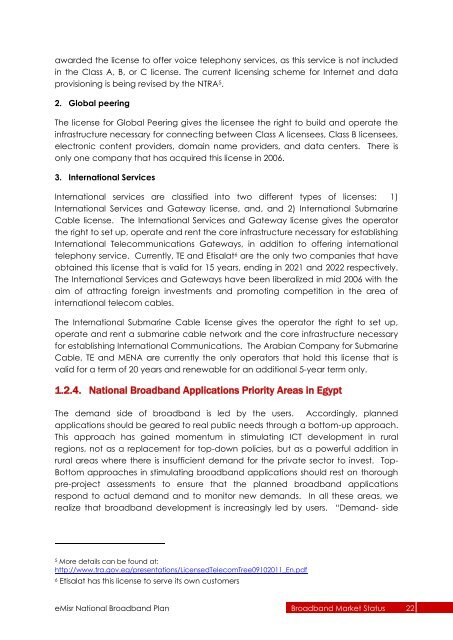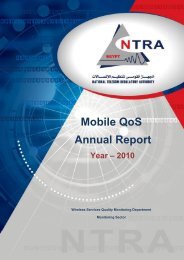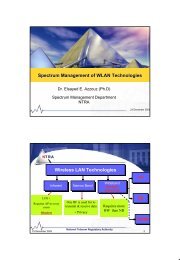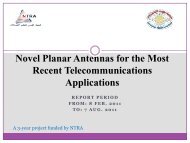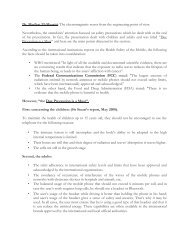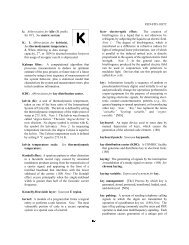awarded the license to offer voice telephony services, as this service is not includedin the Class A, B, or C license. The current licensing scheme for Internet and dataprovisioning is being revised by the NTRA 5 .2. Global peeringThe license for Global Peering gives the licensee the right to build and operate theinfrastructure necessary for connecting between Class A licensees, Class B licensees,electronic content providers, domain name providers, and data centers. There isonly one company that has acquired this license in 2006.3. International ServicesInternational services are classified into two different types of licenses: 1)International Services and Gateway license, and, and 2) International SubmarineCable license. The International Services and Gateway license gives the operatorthe right to set up, operate and rent the core infrastructure necessary for establishingInternational Telecommunications Gateways, in addition to offering internationaltelephony service. Currently, TE and Etisalat 6 are the only two companies that haveobtained this license that is valid for 15 years, ending in 2021 and 2022 respectively.The International Services and Gateways have been liberalized in mid 2006 with theaim of attracting foreign investments and promoting competition in the area ofinternational telecom cables.The International Submarine Cable license gives the operator the right to set up,operate and rent a submarine cable network and the core infrastructure necessaryfor establishing International Communications. The Arabian Company for SubmarineCable, TE and MENA are currently the only operators that hold this license that isvalid for a term of 20 years and renewable for an additional 5-year term only.1.2.4. <strong>National</strong> <strong>Broadband</strong> Applications Priority Areas in EgyptThe demand side of broadband is led by the users. Accordingly, plannedapplications should be geared to real public needs through a bottom-up approach.This approach has gained momentum in stimulating ICT development in ruralregions, not as a replacement for top-down policies, but as a powerful addition inrural areas where there is insufficient demand for the private sector to invest. Top-Bottom approaches in stimulating broadband applications should rest on thoroughpre-project assessments to ensure that the planned broadband applicationsrespond to actual demand and to monitor new demands. In all these areas, werealize that broadband development is increasingly led by users. “Demand- side5More details can be found at:http://www.tra.gov.eg/presentations/LicensedTelecomTree09102011_En.pdf6 Etisalat has this license to serve its own customerseMisr <strong>National</strong> <strong>Broadband</strong> <strong>Plan</strong> <strong>Broadband</strong> Market Status 22
measures should take advantage of this trend and allow citizens participation andcrowd- sourcing in as much as possible” 7 .Facing the challenges of the Egyptian community, the Education sector and theHealth sector have been recognized as priority domains for ICT integration for thepast decade as they relate to basic needs of the citizenry. E-Government has gonethrough incremental phases of development. Albeit challenges of transparencyand security, e-Government is nowadays looking to fulfilling the demands of e-civicparticipation, a field that has become a point of high demand. E-commerce is anessential tool for the development of the economy and particularly for empoweringSMEs. E-commerce is indeed one of the main solutions for employment generationand the generation of new areas of work. Between the establishment of the suitablelegal framework and regulatory steps, e-commerce in Egypt is a promising field thathas not yield its full results yet. “ICT and environment” is a relatively new field of workclosely related to sustainable development that figures on the country‟s mediumand long term plans. E-content development has been a priority of work for thepast decade. Several initiatives have been adopted to trigger a momentum inArabic e- content production and availability in the different sectors.A thorough analysis of the last 10 years can show that the mentioned fields havegone through different phases of uptake and maturity. A clear diversity in adoptionspeed and depth can be noticed. In e- education, a number of national initiativeswere adopted, exploiting the potential of existing <strong>Broadband</strong>, targeting access tostudents, teachers and administration, full re-engineering of schools as learningcenters, and the introduction of state of the art ICT applications. Between ambitiousnational projects, pilots and proofs of concepts, a full scale mainstreaming of ICTsinto schools is still a long term plan that has to cope with challenges of connectivityand capacity building. Health is another sector benefitting largely from broadbandavailability. Nevertheless, the full integration of ICTs into national health strategies isa future step which requires suitable allocations of funds, and a full scheme forscalability. Indeed, as some observers have accurately noted, there is e-health'"pilotitis" in developing countries - a wealth of small scale pilots often not adequatewith the size of the problem tackled - with no repository of information knowledgeabout the results of the initiative. Egypt is no exception and despite the success ofthe pilot projects, a broad range of challenges remains to wider implementation 8 .e-Government has been one of the most ambitious sectors in exploiting <strong>Broadband</strong>penetration, however, in this particular area, a continuous and fast adaptation toconsumers‟ needs becomes a prerequisite especially with the rising public demandsfor accountability and transparency in governmental entities. On the other hand,ICT in the environment has started its work with a clear strategic direction at the7Socio- Economic Assessment of <strong>Broadband</strong> Development in Egypt, p 1238 I. Iakovidis (1998) Towards Personal Health Record: Current situation, obstacles and trends inimplementation of Electronic Healthcare Records in Europe, In International Journal of MedicalInformatics, vol. 52, no 123, pp 105 –117.eMisr <strong>National</strong> <strong>Broadband</strong> <strong>Plan</strong> <strong>Broadband</strong> Market Status 23
- Page 1 and 2: EGYPT2011eMISRNational Broadband Pl
- Page 3 and 4: Message from the Minister of CITIn
- Page 5 and 6: Acknowledgement
- Page 7 and 8: Table of ContentForwardAcknowledgem
- Page 9 and 10: List of TablesTable 1.1 - Main E
- Page 11 and 12: ICT has been a part of Egypt‟s na
- Page 13 and 14: availability, 3) Illegal line shari
- Page 15 and 16: Egypt has successfully established
- Page 17 and 18: The Egyptian broadband market is a
- Page 19 and 20: Figure 1.3 - Mobile cellular subscr
- Page 21 and 22: with TE to provide broadband Intern
- Page 23: their service quality. By the end o
- Page 27 and 28: 3. e-GovernmentMCIT was instrumenta
- Page 29 and 30: fight against poverty. Strategies t
- Page 31 and 32: With the objective of aligning Egyp
- Page 33 and 34: 2.2.3. National and Social Targets
- Page 35 and 36: Million SubscribersA closer look at
- Page 37 and 38: incumbent operator‟s obligation,
- Page 39 and 40: the Egyptian market. One of those b
- Page 41 and 42: As illustrated in Figure 3.4, liter
- Page 43 and 44: 3.9. Legal Aspects of Media and Tel
- Page 45 and 46: 3.12. e-GovernmentExperience has sh
- Page 47 and 48: 3.15. ICT Diffusion to BusinessIn E
- Page 49 and 50: The gap between normal growth rates
- Page 51 and 52: 4.1. Required Investment and Financ
- Page 53 and 54: Based Approach, calculated for the
- Page 55 and 56: TechnologyNPV4 years(for CAPEX 1)NP
- Page 57 and 58: TechnologyNPV4 years(for CAPEX 1)NP
- Page 59 and 60: Figure 4.6 - Broadband Subscribers
- Page 61 and 62: 5Strategic Options
- Page 63 and 64: 5.1. New Era InfrastructureThis sec
- Page 65 and 66: The market trend in Egypt, as in ot
- Page 67 and 68: This option is mutually exclusive w
- Page 69 and 70: Full Local Loop Unbundling and IP B
- Page 71 and 72: spectrum hungry, they need large am
- Page 73 and 74: Subsidizing broadband equipment in
- Page 75 and 76:
4. Unlock the Value of Data and Imp
- Page 77 and 78:
competitiveness to service provisio
- Page 79 and 80:
- Act as a consultant for the Minis
- Page 81 and 82:
- Support environment related ICT s
- Page 83 and 84:
2. Implement an e-voting system usi
- Page 85 and 86:
Key Objectives:Enable more companie
- Page 87 and 88:
5.3. Financing OptionsThere is a wi
- Page 89 and 90:
oadband access. The Government is u
- Page 91 and 92:
Information and Communication Techn
- Page 93 and 94:
contribution from broadband Interne
- Page 95 and 96:
Broadband Market Model (EBMM) 60 de
- Page 97 and 98:
The indirect effect on job creation
- Page 99 and 100:
7Implementation
- Page 101 and 102:
„Universal Service Task Force - U
- Page 103 and 104:
Distribution of users across the co
- Page 105 and 106:
Annexe 1National Broadband Applicat
- Page 107 and 108:
Communicators, collaborators, publi
- Page 109 and 110:
sustainable integrated ICT for deve
- Page 111 and 112:
instance, support elderly people at
- Page 113 and 114:
automation of three public hospital
- Page 115 and 116:
Establishing and Integrating Nation
- Page 117 and 118:
a database containing over 5 millio
- Page 119 and 120:
as an indispensable tool in expandi
- Page 121 and 122:
United Nation Framework Convention
- Page 123 and 124:
establishing the first Egyptian E-W
- Page 125 and 126:
anch. the study come up with that
- Page 127 and 128:
SME’s Progression of ICT Adoption
- Page 129 and 130:
2009The ICT4SMEs program phase thre
- Page 131 and 132:
Egypt has both business-to-business
- Page 133 and 134:
In one of its publications, OECD pr
- Page 135 and 136:
E-content Related to EducationVario
- Page 137 and 138:
Annexe 2Broadband and Job Creation
- Page 139 and 140:
Box 1: Broadband Investments To Spu
- Page 141 and 142:
Annexe 3Acronyms


